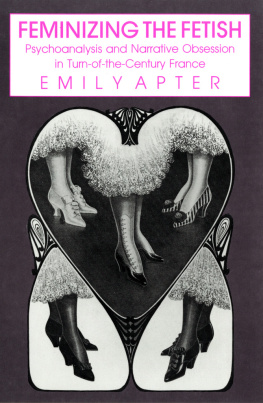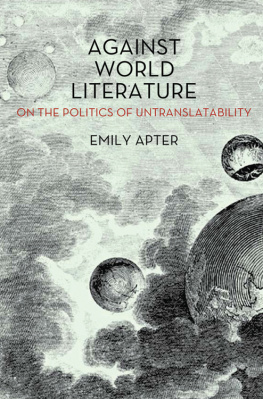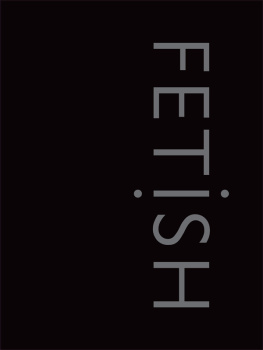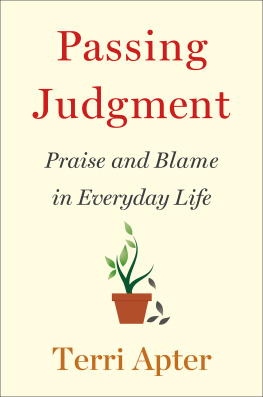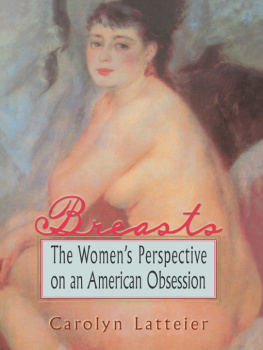Emily Apter - Feminizing the Fetish: Psychoanalysis and Narrative Obsession in Turn-Of-The Century France
Here you can read online Emily Apter - Feminizing the Fetish: Psychoanalysis and Narrative Obsession in Turn-Of-The Century France full text of the book (entire story) in english for free. Download pdf and epub, get meaning, cover and reviews about this ebook. year: 2018, publisher: Cornell University Press, genre: Detective and thriller. Description of the work, (preface) as well as reviews are available. Best literature library LitArk.com created for fans of good reading and offers a wide selection of genres:
Romance novel
Science fiction
Adventure
Detective
Science
History
Home and family
Prose
Art
Politics
Computer
Non-fiction
Religion
Business
Children
Humor
Choose a favorite category and find really read worthwhile books. Enjoy immersion in the world of imagination, feel the emotions of the characters or learn something new for yourself, make an fascinating discovery.
- Book:Feminizing the Fetish: Psychoanalysis and Narrative Obsession in Turn-Of-The Century France
- Author:
- Publisher:Cornell University Press
- Genre:
- Year:2018
- Rating:5 / 5
- Favourites:Add to favourites
- Your mark:
- 100
- 1
- 2
- 3
- 4
- 5
Feminizing the Fetish: Psychoanalysis and Narrative Obsession in Turn-Of-The Century France: summary, description and annotation
We offer to read an annotation, description, summary or preface (depends on what the author of the book "Feminizing the Fetish: Psychoanalysis and Narrative Obsession in Turn-Of-The Century France" wrote himself). If you haven't found the necessary information about the book — write in the comments, we will try to find it.
Emily Apter: author's other books
Who wrote Feminizing the Fetish: Psychoanalysis and Narrative Obsession in Turn-Of-The Century France? Find out the surname, the name of the author of the book and a list of all author's works by series.
Feminizing the Fetish: Psychoanalysis and Narrative Obsession in Turn-Of-The Century France — read online for free the complete book (whole text) full work
Below is the text of the book, divided by pages. System saving the place of the last page read, allows you to conveniently read the book "Feminizing the Fetish: Psychoanalysis and Narrative Obsession in Turn-Of-The Century France" online for free, without having to search again every time where you left off. Put a bookmark, and you can go to the page where you finished reading at any time.
Font size:
Interval:
Bookmark:

For Eleanor and David Apter
The interdisciplinary approaches that I employ to look at the topic of fetishism in this booknarratological, New Historical, hermeneutical, feminist, and psychoanalyticalhave often proved difficult to reconcile. I began with an interest in that fin-de-sicle ethos of morbid sexual obsession permeating realist narrative and the early history of psychiatry alike, and ended with a constellation of abstract analytical and political concerns: the poetics of reification and specularity, the relation between theories of the gaze and the textual representation of scopophilia (love of looking), the gendering of perversion, the question of how to critique the history of feminist social constructionism without relinquishing the subtleties of masquerade, travesty, and mystification. Though in certain respects this interweaving of critical theory with historically grounded nineteenth-century French studies became unavoidably anachronistic, I purposely wanted to blur traditional chronological perimeters in an effort to bring the questions of contemporary psychoanalysis, literary interpretation, and feminism into fruitful confrontation with their formative past.
There remains, however, a definite historical consistency in the books concentration on the turn of the century. As distinct from fin de sicle or early modernism, each of which suggests a clear demarcation on either side of the 1900 divide, the turn of the century evokes a revolving door, allowing for quintessential nineteenth-century genres and stylesrealism, naturalism, decadence, symbolismto be seen surviving into the early twentieth century. Though they clearly atrophy over time (overshadowed by the brilliance of formal experiment in the early avant-garde), it is precisely what happens to these genres as they endure that is of particular interest to me. Contaminated by psychoanalysis, criminology, socioanthropology, trade books on collecting, fashion, and social etiquette, Catholic primers, and mass-market journalism, realist-naturalist-decadent works, from those of the Goncourt brothers to Octave Mirbeau, offer a rich parallel to contemporary genres of prose fiction that plunder the tabloids, the police file, and the psychiatric archive.
Fetishism to most people connotes a monothematic if kinky or unorthodox subject. Examples of fixations on shoes, velvet, fur, hair, gloves, underwear, umbrellas, and cigars that are not just cigars are readily volunteered whenever the term is introduced. Though I am intrigued by the aesthetics of erotic symbolism, displacement, substitution, and the cutting or splitting of anatomical totalities ( le corps morcel ) implicit in localized fixations, I never intended to write a book organized around variety-show fetishes. What interested me more than a catalog of motifs was the sensibility infusing historic bourgeois phantasms, subterranean longings, and gender performances. The logic of psychoanalytical fetishism presumes castration anxiety, penis fixation, or, in the case of women, penis envy. I have sought to emphasize a broader, less gender-restricted conception of partial object substitutionism in sexuality, thereby culturally and historically relativizing those all-purpose referents, the surrogate male phallus and the phallic mother.
It also seemed to me that the museological manias informing fin-de-sicle popular culture corresponded in unexpected ways to our present-day preoccupation with lost aura, sublimation, and ironic peek-a-boo eroticism. Late nineteenth-century bric-a-bracomania, with its domestic altars of eroticized things, brought Freud and Marx into collusion, and this connection, in turn, helped to explain the prevalent and subtly disquieting present-day consumerist practices of collecting, hoarding, displaying, desiring, fondling, possessing, and continually looking.
At its core, this study of fetishism also involves an inquiry into a common reading dispositionthe practice of seizing and worrying literary details, which is second nature to close readers. Close reading is analogous to the conquest of Madame de Rnals arm in Stendhals Le Rouge et le noir. Recounted as a mock-Napoleonic conquest, Julien Sorels seduction of his benefactress is an allegory of synecdoche unbound. Sorel stakes out his territorial claim on Madame de Rnals anatomy, forcing its surrender piece by piece, fingers to shoulder. This episode mirrors the inherently fetishistic process of what Naomi Schor has called reading in detail: that incremental fragment cathexis whereby individual parts eventually crowd together and usurp the original whole. The detail has just this tendency to prick consciousness, to encroach on the terrain of inner feelings, to expand to the point of obsession. Like Barthess punctum or Lacans point tichique, the superfluous, perplexing, derailing detail operates as the object of ones love, apprehension, hunger, or repulsion. It is the detail that affords a point of entry into the aesthetics of textual appropriation, an aperture or rent proceeding from a small, fixed image. Spots, tattoos, bloodstains, stigmas, scars, abrasions, hairy patches, stained clothing, worn keepsakes, fingered relicsthese emerge as those details that stand out as dark symbolic concentrates in the visual field of fetishistic description.
I have anchored my reading of the fetishism of reading in analyses of authors who share a stylistic propensity for what has been referred to as nosological realism. Cliniciens s lettres (to borrow the title of Victor Segalens 1902 thesis on medicalized literariness), the Goncourt brothers, Emile Zola, Guy de Maupassant, Octave Mirbeau, and their epigones and offspring Remy de Gourmont, Georges Rodenbach, Rachilde, Leo Taxil, Augustin Cabans, Octave Uzanne, Cazalis, Paul Bourget each at some level fused the medical observation with the literary chronicle of behavioral aberration. Little studied, their critical legacies often weighed down with platitudes regarding their use of grotesque details, social panoramas high and low, moralized urban landscape, gender stereotypes, the darker side of desire, they have each in their idiosyncratic ways helped to spawn a genre of fetishistic fiction that I have called, borrowing from Freud, pathography a genre fusing biography, cliography (or the historical biographies of legendary men and women), and the clinical case history of exemplary perverts.
Pathology and pathography have, of course, a particular relevance for the present moment. Ironically, at the very moment when critics may be most inclined to throw out epistemological divisions between normal and deviant, or to criticize them within the history of masculinities, femininities, homosexualities, and so on, the mass media seem to rely more than ever on pathographic sensationalism, from the trials of serial killers and child abusers to, on a more mundane level, the fatal flaws of larger-than-life politicians and stars. The nineteenth-century legacy of hereditary taints, characterological and criminological physiognomical signs, mimetic transfers of behavior from class to class, or transmissible diseases of the body and the psyche seems eerily still in place within our own fin-de-siclisms. My interest in nosological or clinical realism (a genre anchored in the art of describing the morbid symptoms of the body) may be interpreted as a reminder that psychoanalytical discourse can always be remedicalized when the threat of disease becomes more real.
And of course the threat of disease has become more real, and, accordingly, there has been a resurgence of medical dystopias in the spheres of art and literature. Though parallels between the nineteenth centurys obsession with syphilis and the twentieth centurys focus on the AIDS tragedy must be treated warily, there are certainly specific reasons why a turn-of-the-century novel such as Leon Daudets Les Morticoles (1894)which describes an island of degenerates managed exclusively by doctorsseems worth reading with an eye to present-day stigmatizations of the sick. Similarly, when Robert Nye re-asks the nineteenth-century question posed by Gaston Danville, Is love a pathological condition? it takes on chilling resonances in the context of more immediate homophobic responses to the AIDS crisis.
Next pageFont size:
Interval:
Bookmark:
Similar books «Feminizing the Fetish: Psychoanalysis and Narrative Obsession in Turn-Of-The Century France»
Look at similar books to Feminizing the Fetish: Psychoanalysis and Narrative Obsession in Turn-Of-The Century France. We have selected literature similar in name and meaning in the hope of providing readers with more options to find new, interesting, not yet read works.
Discussion, reviews of the book Feminizing the Fetish: Psychoanalysis and Narrative Obsession in Turn-Of-The Century France and just readers' own opinions. Leave your comments, write what you think about the work, its meaning or the main characters. Specify what exactly you liked and what you didn't like, and why you think so.

